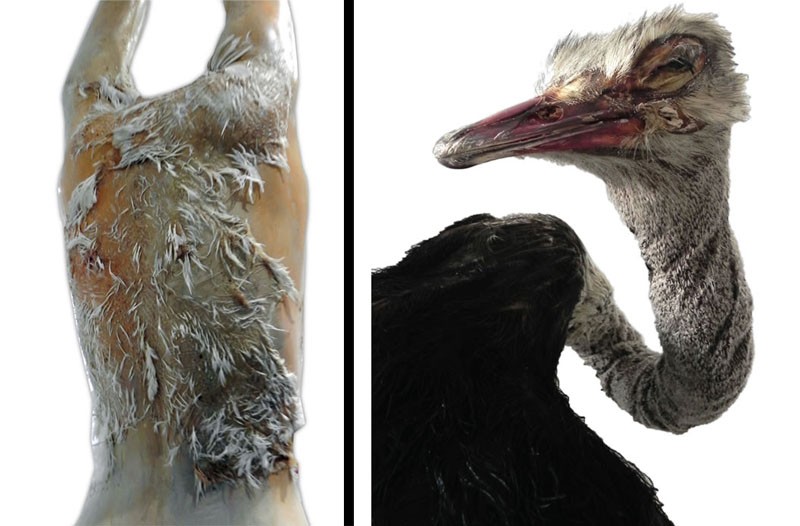
In Nausheen Saeed’s exhibition at Canvas Gallery Karachi, the female body transcends in its primal, raw and naked state

A body can turn into a burden for a human being and not only in old age. That is arguably why, in many religions, body is considered immoral, obscene and sinful. Hence the long periods of penitence performed by the faithful -- in order to negate matter and to elevate themselves to heavens.
Milan Kundera in his The Unbearable Lightness of Being and several other writers have indicated the idea of baseness attached to matter and how, through suffering, one liberates oneself from the shackles of flesh and bones, and experiences a spiritual flight or salvation.
Compared to the Christian notion of (Original) sin connected to body and redemption through penalising flesh, in the Muslim cultures the body is an entity that must be concealed. We have become so used to clothes that we avoid confronting even our own physicality -- we consider it a possible threat to societal and moral order.
In our practices too, we need to negate the body in an attempt to attain spiritual solace. Kundera continues to remind that all body functions are perceived as indecent. Yet we are all bound to our bodies, and the moment the body ceases to function, we turn into a mass that must be immediately disposed off -- by burning, burying or leaving in towers for birds to clear off the dead flesh.
Liberation from body is thus the negation of body. But, in the work of Nausheen Saeed in her solo exhibition ‘Between Heaven and Sky’ (held between Feb 16-25, 2016, at Canvas Gallery, Karachi), the body is acknowledged as a means to celebrate as well as a vehicle for salvation. This may remind of Tantric philosophy but Saeed has approached her imagery from another, more personal and formal, point of view. In our society, women are supposed to hide their bodies from the outside world as well as internalise this feeling. Growing up girls are instructed to walk in such a manner that their changing figure must not be noticed by anyone. This early lesson in self-denial and the daily ordeal of gazes of frustrated males imprint the notion and enhance the feeling of disassociating from one’s physicality.
In the work of Nausheen Saeed, the female body is not only presented fully, it has a confident and commanding attribute. It exists without any support and can transcend in its primal, raw and naked state. Saeed has attached feathers to some parts of the female figures (Meatless Days I and Meatless Days II) which in a sense endow them with a power to levitate the world and experience other possibilities and destinies. Whether about to take off or descending, these figures are suspended between the realm of humans and birds.
The bird feathers allude to other readings. Many ardent supporters of animal rights enjoy sumptuous meals made of mutton or poultry. They forget the way hens are slaughtered everyday in our roadside markets. Saeed’s act of layering skin and placing feathers of these birds on bodies of human beings could be a way to invoke the presence of that familiar violence that has become so much part of our lives that it ceases to be violence anymore.
She draws a link in her statement: "We live in times/society where violence prevails everywhere. We notice only when some big or stark disaster happens or those incidents make us notice/comment on the terrorism happening but we ignore the banal everyday violence trespassing our daily life. Be it with children on streets or women at home in any relationships….. Birds, animals, trees, plants, land, roads; even the weather cycle is being violated. No matter of how much we suffer we all contribute to it….".
The work at Canvas Gallery suggests a way forward in Saeed oeuvre as she has been working with the female figure in different ways, sometimes transforming them into clothes, flowers, milk containers or luggage pieces. The new work seemed to be a landmark in her aesthetic choices and pictorial preference. In these sculptures, instead of total transformation, the bodies exist between a no-man’s (or no-woman’s?) land -- between humans and animals.
Since ancient times, man has been blending the two in his art (the most archaic example being the ivory carving ‘Human with Feline Head’ from Germany ca. 30,000-28,000 BC, and the most recent are the cartoons of Walt Disney). But in Saeed’s art the amalgamation emerges as a depiction of devastation, frustration and the success of transcending one’s limitation -- be those physical, emotional, psychological or cultural.
The most spectacular work was ‘Approach’, a sculpture of a kneeling female with her head replaced with that of an ostrich. A portion of an actual creature’s body was joined with detailed rendering of a woman bent in a posture that could be seen from multiple perspectives and meanings. The work demonstrated the command and capability of the artist who has used two realities -- a taxidermist part of bird and cast of a naked woman in such a scheme that one was bound to believe in the reality of that unique being. It was done in a way that the sculpture became an impressive hybrid of form and content.
The phenomenon of hybrid is important in art because artists, being disciples of the divine, are always trying to edit, correct and add to their surroundings. In the work of Nausheen Saeed, this language is employed in a tone which according to the artist is an "act of transformation, formal, mythological, societal and psychological" and from here she seeks "to locate an ideal self/body that transcends the ordinariness of life, expectations and assumptions. Analogies to other forms of life, if on the one hand denote a freedom of mind which can take the flight of fancy whenever, and wherever it requires, at the same instance it describes the despicable situation of living."